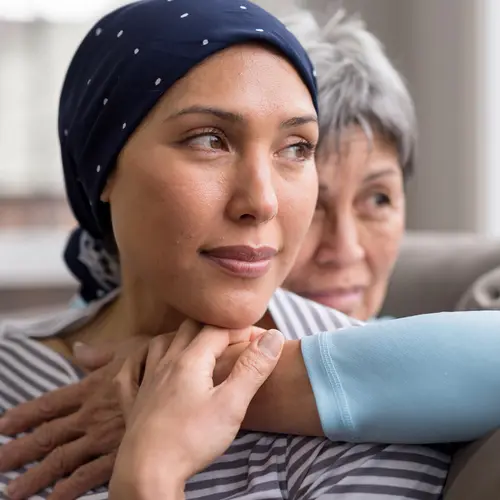Breast cancer is one of the most common cancers affecting American women, and is second only to lung cancer as a leading cause of cancer death in women. The number of breast cancer cases has started to decrease slightly since the 1990s after a consistent rise during the 20 years prior. Death rates from breast cancer continue to decrease over time, in part, due to a greater emphasis on screening with routine breast exams and mammography.
These screening tools often can detect breast cancer at an earlier stage, when it is more treatable, which helps explain why the number of breast cancer cases initially rose despite a decline in the death rates.
The exact cause of breast cancer has not been established, but there are risk factors that may play a role. A risk factor is a trait or behavior that increases a person's chance of developing a disease or makes a person susceptible to a certain condition. Risk factors for breast cancer include:
- Being female (Breast cancer can occur in men, but it is rare.)
- Getting older
- Having a family history of breast cancer
- Having a personal history of cancer in one breast
- Having your first child after age 30 or never having children
- Getting your period early in life (before age 12)
- Reaching menopause after age 55
- Being overweight (especially in the waist)
- Long-term use of combined (estrogen and progestin) hormone replacement therapy
- Being a carrier of an altered form of the breast cancer gene, BRCA1 or BRCA2 (Genes are the basic unit of heredity. They contain instructions for a cell's development and function, and can be passed on from parents to children.)
- Having received chest radiation
- Drinking more than two alcoholic drinks per day
- A diet that's high in fat and low in fruits and vegetables
Does Race or Ethnicity Affect Breast Cancer Risk?
All women should be aware of their risk for breast cancer. It can affect women of every age, race, and ethnic group. However, the rates of developing and dying from breast cancer vary among various racial and ethnic groups.
According to the National Cancer Institute, white, non-Hispanic women have the highest overall incidence rate for breast cancer among U.S. racial/ethnic groups, while Native-American women have the lowest rate. Among women ages 40-50, African-American women have a higher incidence of breast cancer than white women and the highest death rate from breast cancer. Asian-American women have the lowest death rate.
The higher death rate from breast cancer among African-American women has been linked to the stage, or extent, of the cancer at the time it's diagnosed. Studies show that African-American women tend to seek treatment when their cancer is in a more advanced, less treatable stage.
In addition, a higher percentage of African-Americans and Hispanics lack a regular source of health care, such as a primary care provider. Having a primary care provider increases the chance that a person will receive appropriate preventive care -- including routine check-ups and screenings -- that may detect breast cancer at an early stage.
Several other factors have been found to impact the breast cancer incidence and death rates among racial and ethnic groups. Differences in certain lifestyle behaviors -- such as diet, exercise, and acceptability of smoking and alcohol use -- may raise the risk of many diseases, including heart disease and breast cancer.
There are also various factors that may contribute to the lower rates of routine and preventive health care among minority populations, including:
- Socioeconomic factors. These include income level, lack of transportation, and lack of access to health insurance or health care facilities, including screening programs.
- Language and communication barriers. These barriers can interfere with a person's ability to discuss health concerns and develop trust in a primary care physician.
- Education about or understanding of health care risks and symptoms. Women who are not aware of breast cancer risks and symptoms are more likely to wait to seek treatment until their symptoms interfere with daily tasks.
- Cultural practices and expectations. Women of some cultures may turn to traditional or "folk" remedies before seeking treatment from a doctor.
- Cultural and/or religious beliefs related to health and health care. Strong beliefs in healing and miracles, as well as distrust of the health care system, may keep some people from participating in routine preventive care.
There continues to be an enormous need for more education and resources to reach women, particularly minorities, with the message of breast cancer screening and prevention. For those who are at high risk, careful monitoring and follow-up care with a primary care provider are especially vital.

